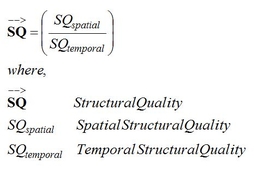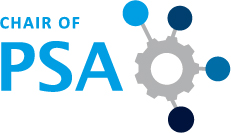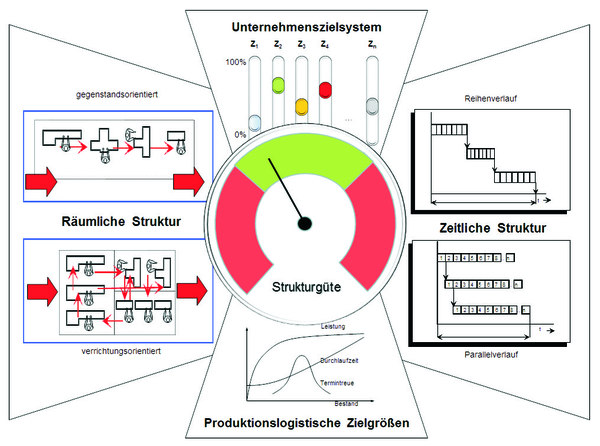Scientific news ticker october 2016
The Structural Quality: An indicator to verify the appropriateness of production structures
October 2016 The production industry mainly due to the globalization of sales and purchase markets is faced with new kinds of general conditions, resulting in decreasing quantities of similar products and, at the same time, increasing numbers of customer-specific variations. A clear change is noticeable, from multi-variant large-scale production towards customer-specific batch production, which comes as a result of this very individualization of the customers’ demands. This often leads to short-cycle adjustments within the factory and production structure, since mastering these types of production largely depends on the implemented system structure. As for the operating routine, there is no objectively measurable parameter to verify the appropriateness of the installed system structure: The Structural Quality, the development of which is currently undertaken by several research activities at the Otto von Guericke University in Magdeburg.
Analytical approaches for checking or evaluating an installed system structure are contrasted by design approaches to pre-determine flexible system structures in the context of factory and production structure planning. Deficits in such structure configurations are mainly provoked by the mostly one-sided observation of the spatial aspects of structuring (before Start-of-production SOP), since the temporal component will usually only be determined by the time sequence of the production processes (after the real SOP). Only the temporal dependency of type, number, linking and arrangement of the system elements is considered with the help of dynamic structuring approaches.
A fact often ignored is that, besides the arrangement of the system elements, it is also the manner of their interactions which defines an entire system structure. Therefore, an evaluation of the structure’s appropriateness is necessary which considers both the spatial and the temporal aspects of production structures.
MODEL FOR STRUCTURAL EVALUATION
As a matter of fact, production systems exist as any field of known matter in space and time and are classified; thus, they do possess a structure in terms of a certain organization of the system (System Configuration).
Based on the system-specific type and number of system elements (the so-called System Composition), a structure describes the basic order of a system (the so-called System Setup) depending on the existing system interrelations. As a result, it determines the function of the system (the so-called System Behavior).
The System Setup is, therefore, determined by the existing System Composition, i.e. the type and number of all system elements, depending on the type, orientation and intensity of the system-inherent, physical interrelations between the system elements. This preferably economical arrangement of system elements for implementing the processing sequences (transformation process) is called Spatial Structure.
The setup of a production system mainly depends on the System Composition and is reflected in the plant layout as regards the Spatial Structure. Consequently, the System Setup should be understood as function of the System Composition and the concrete Spatial Structure:
![]()
These determinations usually occur during the planning stage of a production system.
The System Behavior is characterized by the type, number and order of any kinds of processes that might be implemented through the functional linking of the system elements (processing sequences). The chronological structuring of the processes into segments and their timely interaction is called Temporal Structure.
The concrete behavior of a production system will only become transparent during operation. Therefore, the System Behavior is based on the System Setup defined before and causally influenced by the selection of the Temporal Structure. Accordingly, the System Behavior can be understood as function of the System Setup and the selected Temporal Structure:
![]()
Previous methods for evaluating the operational quality of a production structure mainly focus on three parameters in this respect: throughput time, output rate and the work in progress (WIP) as system-inherent stock. Completing this by adherence to delivery dates, we will have all the figures for the so-called logistic performance indicators. These are usually visualized in form of operating curves, thus locating the current operating point of a production system multi-dimensionally.
Based on the operating curve, a theoretical optimum for running a production structure can be determined. The optimization, however, takes place in a way that all logistic performance indicators are considered equally for the operational target, by determining the relative maximum of the output with regard to the shortest possible throughput time.
Moreover, specific versions of the characteristic curves depend on different conditions for the respective production system (e.g. the integration of operating systems into the material flow), i.e. the comparability of operating points depends on the respective aspects of the production structure.
Basically, the characteristic of a production program for a concrete production system - yet considered exogenously - influences the System Composition as well as the Spatial and Temporal Structure. Except for the production program, all factors can be directly influenced by the respective enterprise.
While in case of an identical Spatial Structure of the characteristic curve approach the operating points of a system might be compared for different Temporal Structures, e.g. with changed controlling processes, it is not easy to make a reverse assessment with the help of the logistic performance indicators. This is due to the fact that changing the Spatial Structure often also induces a change in the resource basis as regards the System Composition (change in element amount regarding type and/or number). Only with unchanged type and number of system elements, a consistent basis for evaluation is guaranteed. Otherwise, the different dimensioning and/or a changed functional scope of individual resource elements distort the comparison’s significance. In order to compensate for this deficit, it is required to normalize the parameters in question. Thus, a normalized presentation of the logistic performance indicators is required to be able to draw conclusions which are largely independent from the system-specific conditions.
MAIN FINDINGS THE STRUCTURAL QUALITY
In order to assess the quality of a present production structure it is necessary to determine adequate reference values for the normalization described above.
For the output rate and the WIP it is advisable to relate these values to the ideal operating point, thus expressing them as relative values. This is easiest for the output rate. If the maximum output rate is set on 100%, then the medium output rate can be directly converted and interpreted as medium utilization.
For the WIP it is advisable to normalize with the ideal minimum WIP as reference point. The resulting relative WIP indicates to which degree the absolute WIP of a production system deviates from the ideal minimum WIP. If the ideal minimum WIP and the maximum utilization are set on 100% respectively, the normalized output rate operating curve will be the result. This way, it can be described in normalized manner how a change in WIP affects the utilization of the observed production system. A relative measure for the throughput time or the range respectively is the flow rate. If the mean WIP is similar to the funnel formula set in relation to the output rate, the weighted flow rate will be obtained as normalized value for the operating range.
As a result of this normalization, the calculation equations for the utilization, the relative WIP and the weighted flow rate do not include the specific order (production program) and direct capacity figures (system composition) any longer. The resulting normalized operating curves are therefore mainly system-independent, focusing exclusively on the Spatial and Temporal structure of the observed production system.
Accordingly, the Structural Quality of production systems can be seen as vector of the quality of the Spatial and Temporal structure:

Basically, the Structural Quality provides the planner with a number to evaluate an implemented production structure. Moreover, the Structural Quality may also serve as a planning index when reconfiguring an observed production structure. Such a reconfiguration is based on changing general conditions (mainly the change of the production program) as well as on changes of system-inherent characteristics: this refers to the System’s Composition, Setup and Behavior.
CONCLUSION
Different business objectives usually lead to different production structures. Depending on the configuration of the production structure, it either features a utilization maximization based on the job-shop principle (technology pooling) or the focus is set on throughput time minimization based on the object principle (process flow).
Changing market demands require the modification of production programs, which increasingly forces company representatives to evaluate the quality of the currently installed production structure. For this matter, the present research approach introduced a parameter based on system-theoretical analyses: The Structural Quality.
A structure’s effectiveness is rated according to the fundamental functionality of a certain operational capacity (output per observed period) that can be provided, and that will, consequently, result in a fixed productivity. The latter can mostly be taken as planning requirement from a predicted production program.
The Structural Quality, however, shall be used to analyze the efficiency, that is the temporal and cost-oriented input-output-relation with the idea of minimizing the factor input while keeping the (planned) output quantity.
First practical experiences lead to the following potentials concerning further research and development:
- Case-specific analysis of ideal forms of production structures and development of basic patterns concerning the structural quality
- Integration of the Structural Quality into operation-specific structural planning by way of a target-oriented formation sequence of production structures
- Enabling tool support as dynamic evaluation system by using pre-configured structure models.
The complete contribution is part of APMS (Advances in Production Management Systems) 2016. Publication planned end of 2016.
Contact: Dipl.-Wirtsch.-Ing. Matthias Heinicke, Dr.-Ing. Ulf Bergmann







